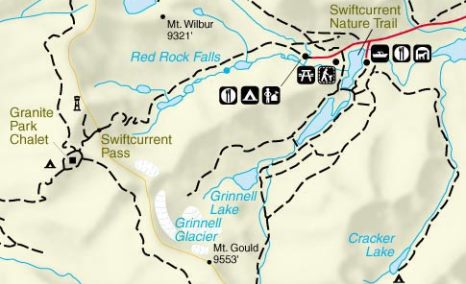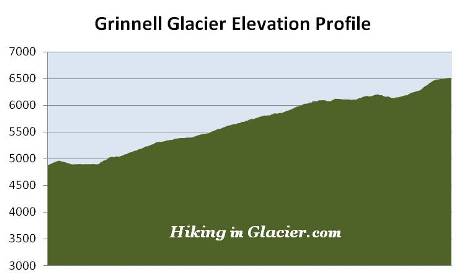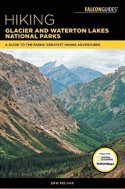
Grinnell Glacier
| Trail Features: | Outstanding views, Glaciers, Meadows | 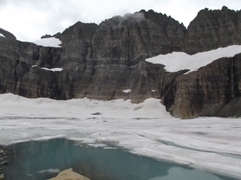 |
|||
| Trail Location: | Many Glacier Hotel Boat Dock | ||||
| Roundtrip Length: | 7.6 Miles | ||||
| Total Elevation Gain: | 1840 Feet | ||||
| Avg. Elev Gain / Mile: | 484 Feet | ||||
| Highest Elevation: | 6515 Feet | ||||
| Trail Difficulty Rating: | 11.28 (strenuous) | ||||
| Parking Lot Latitude | 48.79667 | ||||
| Parking Lot Longitude | -113.65815 | ||||
Trail Description:
The standard hike to Grinnell Glacier in Glacier National Park begins from the Grinnell Glacier Trailhead, located roughly one-half mile past the turn-off for the Many Glacier Hotel. However, you can shave 4.4 miles off your roundtrip hike by taking the two shuttle boats across Swiftcurrent Lake and Lake Josephine. This hike description assumes you'll use the shuttle boats, therefore this hike begins from the boat dock at the Many Glacier Hotel. Please note that there is a fee to board the two boats.
The early morning express boat shuttles hikers across Swiftcurrent Lake in about 8 minutes. From the landing on the south side of the lake you'll take the paved trail over to Lake Josephine. This short 0.2-mile path climbs roughly 80 feet before descending back down to the Lake Josephine boat dock. From there you'll board the Morning Eagle and take the 12-minute shuttle across Lake Josephine.
From the boat landing on the south shore of Lake Josephine hikers should proceed along the trail that leads towards the right. After walking a very short distance you'll reach a junction where you'll turn right once again to continue towards your destination.
From the junction the trail circles around the south end of the lake. Much of this segment travels along a raised boardwalk that keeps hikers above a wet marshy area. Immediately after exiting this short section you'll arrive at the North Shore Lake Josephine Trail junction, which veers towards the right. The path leading to Grinnell Glacier continues up the hill, and from this point, will climb a thigh-burning 135 feet over the course of the next tenth-of-a-mile.
At roughly four-tenths of a mile from the boat landing hikers will reach the Grinnell Glacier Trail. A turn to the right will lead you back to the Grinnell Glacier Trailhead in Many Glacier. To continue towards Grinnell Glacier hikers should turn left here. From the junction the trail levels out for a bit, and gives hikers a chance to catch their breath.
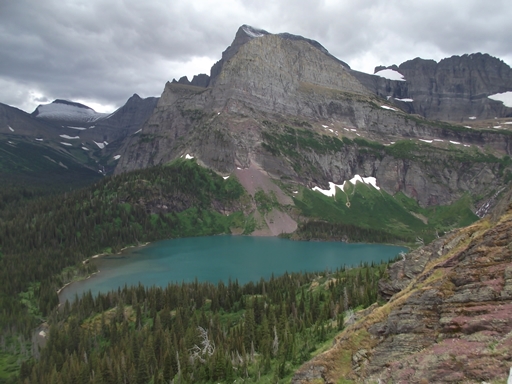
At roughly three-quarters of a mile you'll begin to enjoy your first good views of Grinnell Lake in the valley below. Angel Wing and Mt. Gould will tower above it from this vantage point. Walk a little further up the trail and you'll also see Grinnell Falls tumbling hundreds of feet down the headwall above the west end of the lake.
There are three glaciers that will be visible as you proceed up the valley. Sitting just below the Garden Wall is The Salamander, which is the predominate glacier visible from Lake Josephine, as well as during the early portions of this hike.
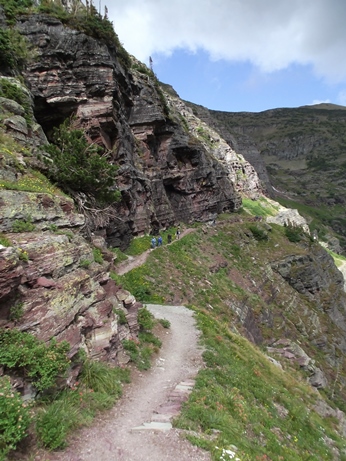 As the trail continues to climb hikers will pass through several beautiful alpine meadows with numerous wildflowers. You'll also notice a couple of small waterfalls tumbling down the steep slopes of 8851-foot Mt. Grinnell on your right. At roughly 1.8 miles from the boat landing, after climbing a series of switchbacks, take a look above Grinnell Falls for your first good view of Grinnell Glacier.
As the trail continues to climb hikers will pass through several beautiful alpine meadows with numerous wildflowers. You'll also notice a couple of small waterfalls tumbling down the steep slopes of 8851-foot Mt. Grinnell on your right. At roughly 1.8 miles from the boat landing, after climbing a series of switchbacks, take a look above Grinnell Falls for your first good view of Grinnell Glacier.
At 2.2 miles hikers will reach a long stretch of trail that hugs a cliff face. There are a couple of places where the path travels across a fairly narrow ledge with some fairly steep drop-offs. If you take your time, however, most people shouldn't have any problems here. Hikers should also keep an eye out for bighorn sheep and mountain goats in this area. On our most recent hike we saw at least 15 bighorn sheep, most of them rams, resting and grazing in the meadows just below the footpath.
As with all the other trails in the Many Glacier area, you should be aware that you're traveling through prime grizzly bear habitat on this hike. In 2010 former Columbus Zoo keeper and television personality, Jack Hanna, was charged by a 150-pound grizzly bear near this stretch of the trail. Hanna, along with three other hikers, rounded a blind corner near Thunderbird Falls where they came face-to-face with a sow grizzly and her two yearling cubs. The sow was only ten feet away before Hanna was able to repel it with a third burst of bear spray.
At roughly 3.2 miles hikers will arrive at a rest area where you'll find a couple of wooden benches and a pit toilet. Above the rest area the trail begins to climb a series of steep switchbacks that ascend along a boulder-strewn moraine. As you proceed up this short section take a moment to look down the valley for a grand view of Grinnell Lake and Lake Josephine, as well as Sherburne Lake in the far off distance.
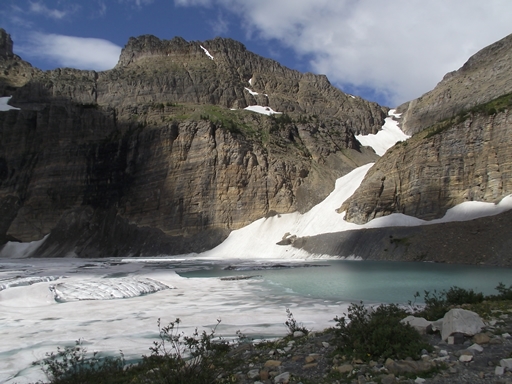
At roughly 3.6 miles from the boat landing hikers will finally reach Grinnell Glacier Viewpoint where you'll enjoy commanding views of the 152-acre glacier, Upper Grinnell Lake, the Garden Wall (part of the Continental Divide), as well as 9553-foot Mount Gould. Looking towards the southeast, in the notch on the Garden Wall just below the summit of Mount Gould, is Gem Glacier, the smallest named glacier in Glacier National Park.
In years past rangers would lead hikes out onto the glacier itself. However, as a result of its retreat in recent years they no longer do this. The park does allow visitors to venture onto the glacier, but they highly recommend that you don't go alone, or go too far. It's especially dangerous when there's fresh snow on the ground, which can easily hide deep crevasses.
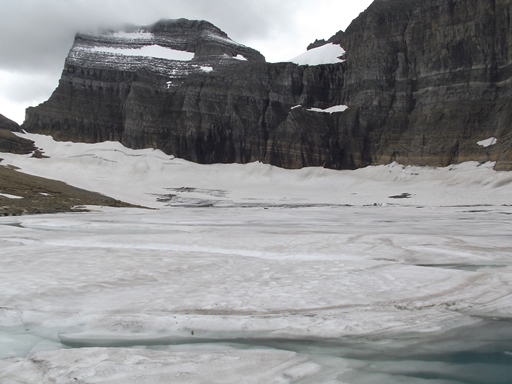
In 1850, at the end of what has been referred to as the Little Ice Age, Grinnell Glacier, combined with The Salamander, measured 710 acres in surface area. As of 2005 the now separated glaciers cover less than 200 acres.
The glacier was discovered in 1885 by George Bird Grinnell, an early American conservationist, explorer, writer and founder of the Audubon Society. Grinnell was so inspired by the scenery during his first visit to the area that he spent the next two decades working to establish it as a national park. Interestingly, during his final visit to the glacier in 1926, Grinnell noted in his diary that "the glacier is melting very fast and the amount of water coming from it is great. All these glaciers are receding rapidly and after a time will disappear."
